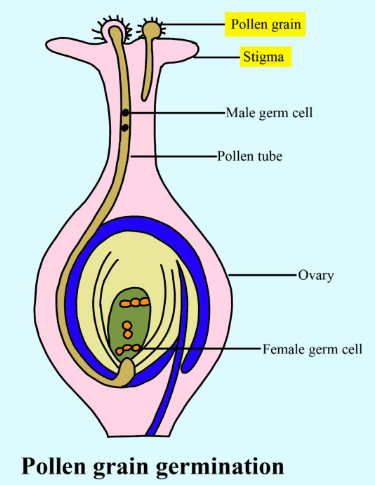
Distinguish between unisexual and bisexual flowers giving one example of each. Draw a diagram showing process of germination of pollen grains on stigma and label the following parts:
(i) Female germ cell
(ii) Male germ cell
(iii) Ovary
Answer
516.9k+ views
Hint: The flowers are the main part of reproduction in the case of the angiosperms thus they are called the flowering plants. The male part of the flower constitutes the pistil while the female part constitutes the carpel.
Complete answer:
The difference between the unisexual and the bisexual flowers are as follows:
The process of pollination is where the pollen from one plant lands on the stigma of another flower or the same flower. The germination of the pollen grain on the stigma starts when the pollen tube extends and moves towards the ovule of the female where it secretes two male gametes (sperms) and then fuses when the egg cell of the female and results in fertilization.
After the process of pollination where the transferring of male gametes takes place towards the female gamete, the process of fertilization begins in the flowers. This process occurs with the help of various insects, birds, and other organisms that are termed the pollinating agents. These pollinating agents are differentiated into two categories: biotic (living) factors like insects, birds, etc, and abiotic (non-living) factors like wind, water, etc.
-Fertilization occurs mainly in four stages:
(a) Germination of pollen tube on stigma
(b) Growth of pollen tube
(c) Pollen tube entry into the embryo sac
(d) Fusion of gametes

Note:
During angiosperm reproduction, two products are formed: a zygote and the endosperm. A zygote will grow and develop into an embryo, or into a baby plant. The food source of plant embryos is the endosperm formed. This process is called double fertilization, and it is a unique characteristic of a flowering plant.
Complete answer:
The difference between the unisexual and the bisexual flowers are as follows:
| Unisexual flower | Bisexual flower |
| The flowers either consist of the male part (androecium) or the female part (gynoecium), but both are not found in the same flower. | The flower contains both the male and the female parts in the same flower. |
| They are of two types: the monoecious or the dioecious flowers. | They are also called the androgynous flowers. |
| The monoecious (having both male and female parts on the same flower) flowers undergo cross and self-pollination, while the dioecious undergo cross-pollination. | The androgynous flowers (having both male and female parts on the same flower) flowers undergo cross and self-pollination. |
| Due to the absence of either male or the female part, they are called the incomplete flower. | They have both male and female parts on the same flower, they are called the complete flower. |
| Example: Papaya, watermelon, corn, etc. | Example: Hibiscus, rose, sweet pea, etc. |
The process of pollination is where the pollen from one plant lands on the stigma of another flower or the same flower. The germination of the pollen grain on the stigma starts when the pollen tube extends and moves towards the ovule of the female where it secretes two male gametes (sperms) and then fuses when the egg cell of the female and results in fertilization.
After the process of pollination where the transferring of male gametes takes place towards the female gamete, the process of fertilization begins in the flowers. This process occurs with the help of various insects, birds, and other organisms that are termed the pollinating agents. These pollinating agents are differentiated into two categories: biotic (living) factors like insects, birds, etc, and abiotic (non-living) factors like wind, water, etc.
-Fertilization occurs mainly in four stages:
(a) Germination of pollen tube on stigma
(b) Growth of pollen tube
(c) Pollen tube entry into the embryo sac
(d) Fusion of gametes

Note:
During angiosperm reproduction, two products are formed: a zygote and the endosperm. A zygote will grow and develop into an embryo, or into a baby plant. The food source of plant embryos is the endosperm formed. This process is called double fertilization, and it is a unique characteristic of a flowering plant.
Recently Updated Pages
A man running at a speed 5 ms is viewed in the side class 12 physics CBSE

State and explain Hardy Weinbergs Principle class 12 biology CBSE

Which of the following statements is wrong a Amnion class 12 biology CBSE

Two Planoconcave lenses 1 and 2 of glass of refractive class 12 physics CBSE

The compound 2 methyl 2 butene on reaction with NaIO4 class 12 chemistry CBSE

Bacterial cell wall is made up of A Cellulose B Hemicellulose class 12 biology CBSE

Trending doubts
What are the major means of transport Explain each class 12 social science CBSE

Which are the Top 10 Largest Countries of the World?

Explain sex determination in humans with line diag class 12 biology CBSE

Draw a labelled sketch of the human eye class 12 physics CBSE

How much time does it take to bleed after eating p class 12 biology CBSE

Suicide bags of cells are aEndoplasmic reticulum bLysosome class 12 biology CBSE




